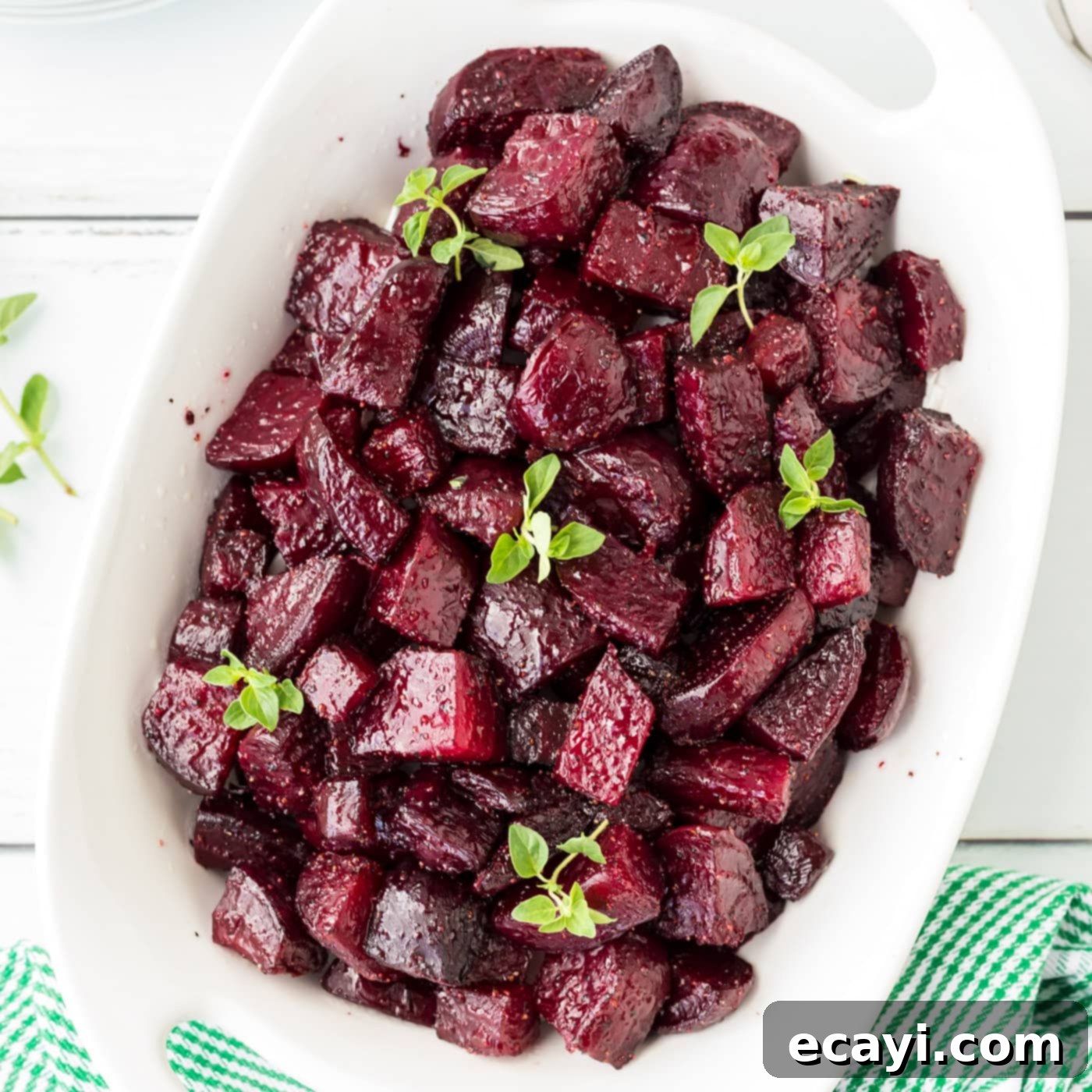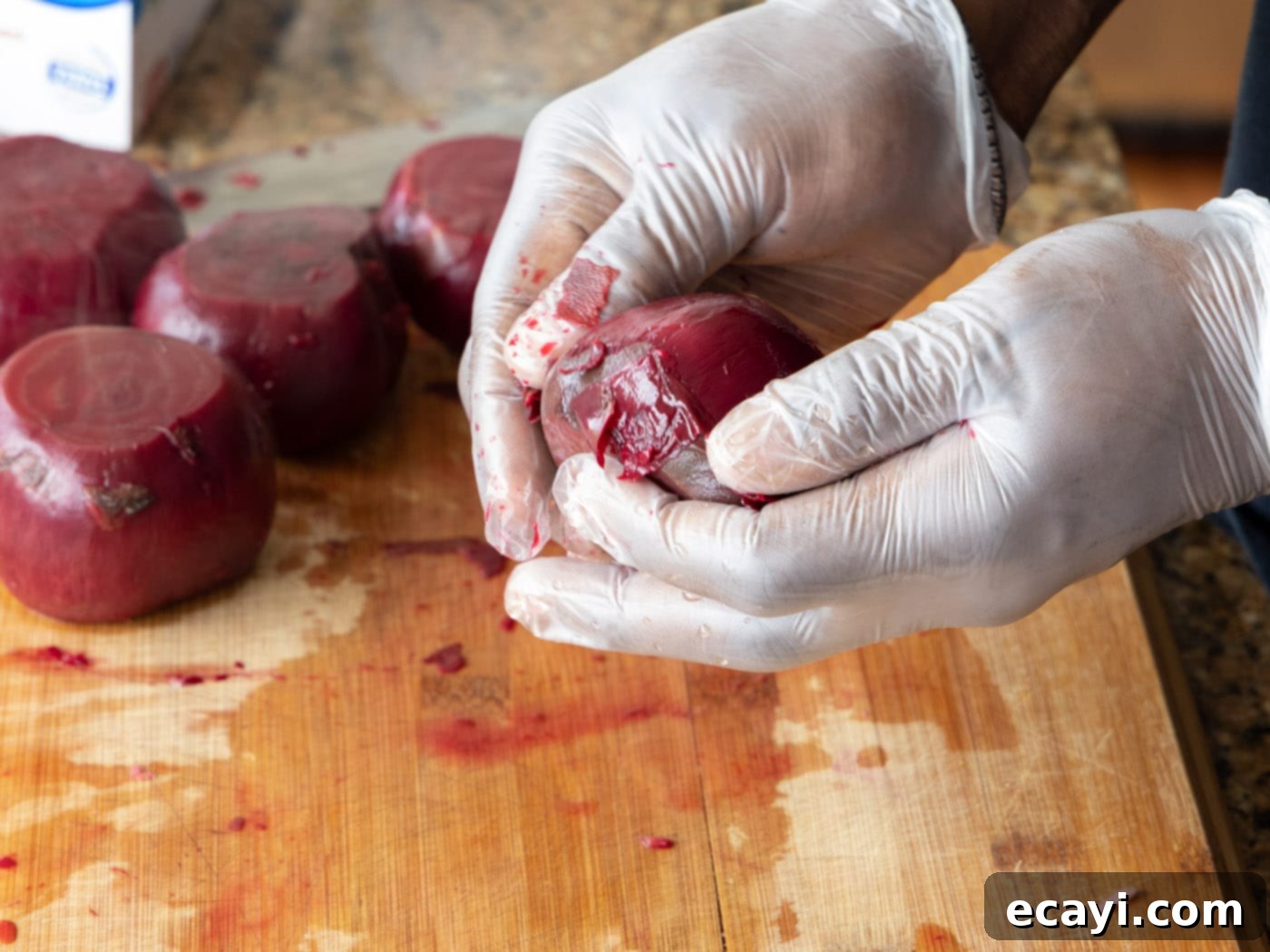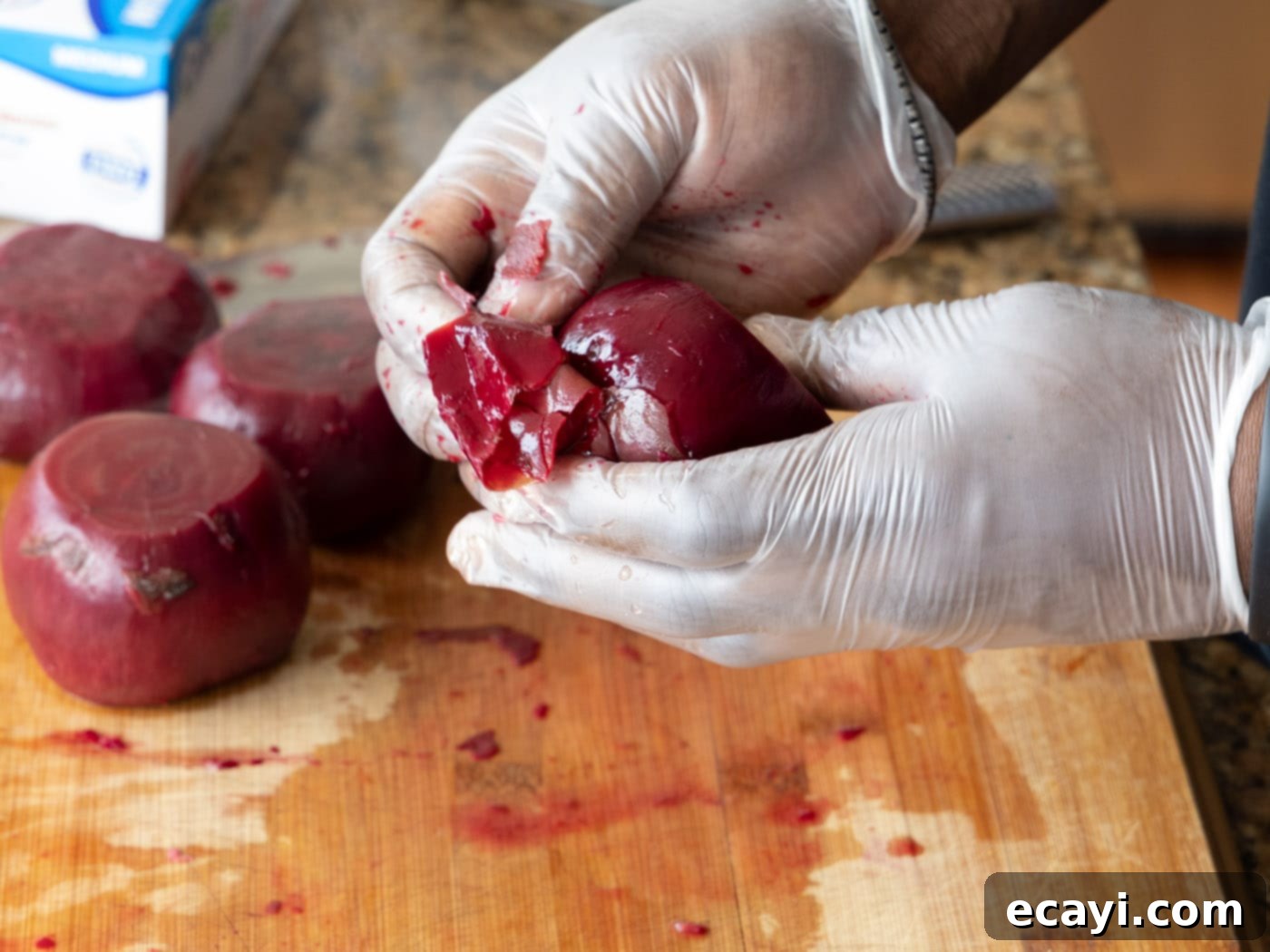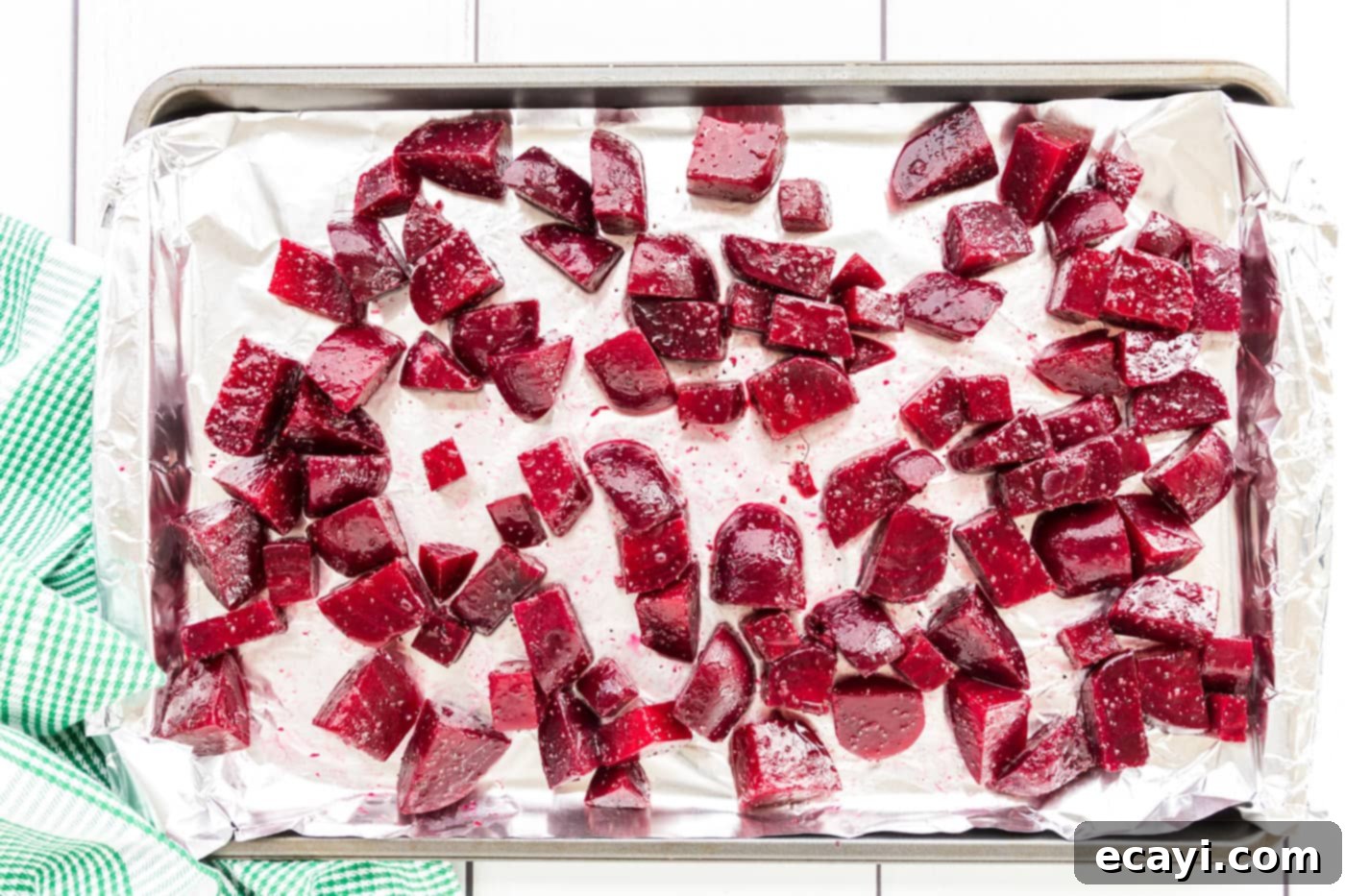Perfectly Tender Oven Roasted Beets: A Simple Guide to Sweet & Earthy Perfection
Discover the secret to making impeccably tender and incredibly flavorful oven-roasted beets with this easy-to-follow recipe. By first boiling the beets, we unlock a method that not only makes peeling a breeze but also enhances their natural sweetness, which is beautifully balanced by a subtle earthy bitterness. The result is a vibrant, ultra-tender, and deeply satisfying side dish that will elevate any meal.
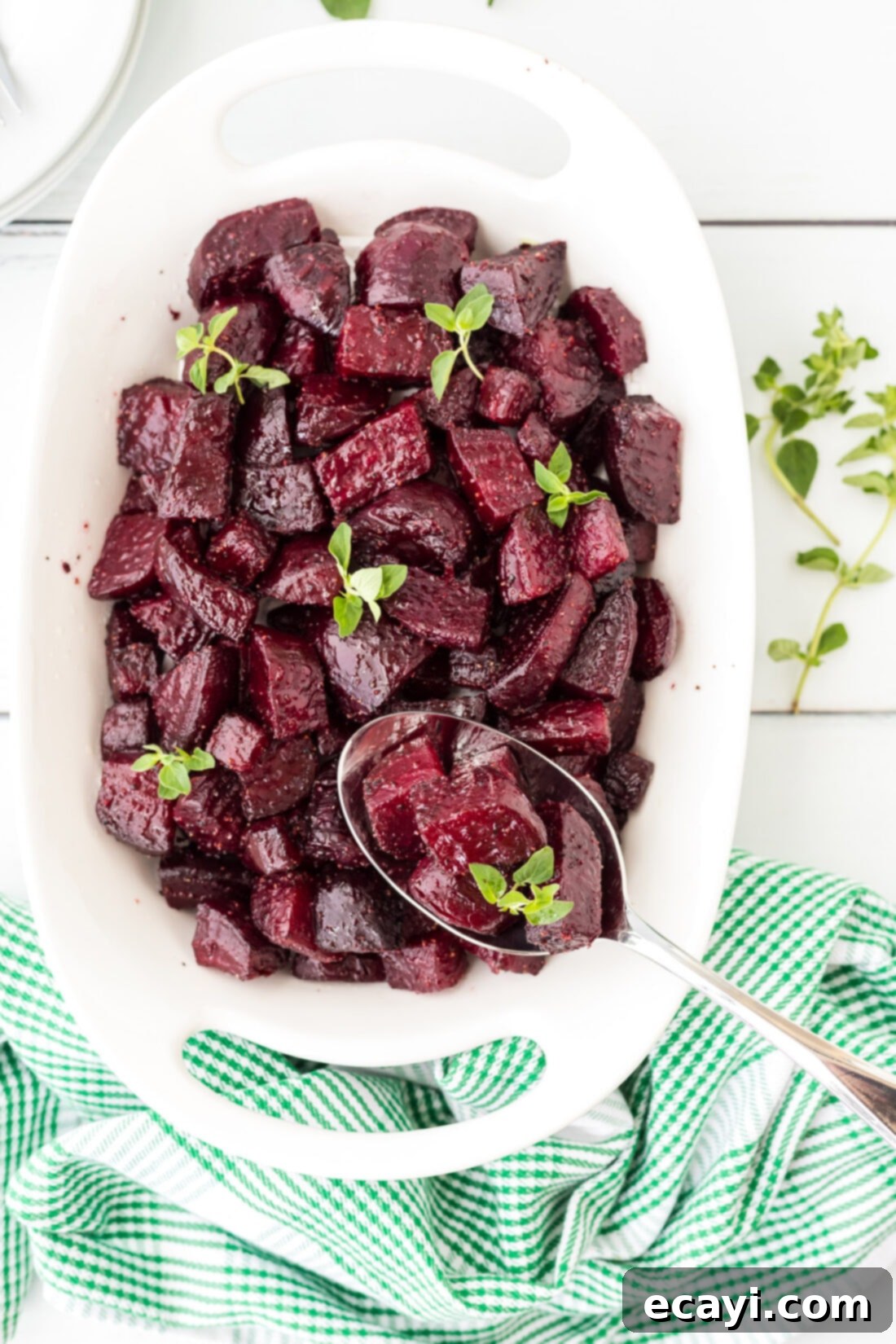
Why This Oven Roasted Beets Recipe Is a Game-Changer
This recipe stands out for its simplicity and the incredible results it delivers. We employ a two-step cooking process that ensures maximum tenderness and flavor, making it a go-to method for beet lovers and newcomers alike.
The Advantage of Pre-Boiling Beets
The key to this recipe’s success lies in the initial boiling stage. Unlike roasting raw beets, which can result in tough skins that are difficult to remove, a quick boil softens the beets significantly. This means that once they’re cooked, their skins will literally slide right off with minimal effort, saving you time and frustration. This pre-boiling technique also ensures the beets are tender throughout before they even hit the oven.
Flavor Transformation Through Roasting
After boiling and peeling, the beets are chopped, tossed with a simple seasoning of olive oil, salt, and pepper, and then roasted in the oven. This roasting step is where the magic happens. The high heat of the oven caramelizes the natural sugars in the beets, intensifying their sweetness and creating a rich, earthy depth of flavor that’s simply irresistible. The edges become slightly crisp while the interior remains incredibly tender.
Unmatched Versatility and Meal Prep Potential
One of the best aspects of these roasted beets is their incredible versatility. You can easily scale up this recipe by doubling or tripling the ingredients to prepare a larger batch. These perfectly cooked beets can then be stored in the refrigerator or frozen for future use, making them an excellent choice for meal prepping. They are absolutely stunning when integrated into a pearl couscous salad with feta and beets, adding a vibrant color and sweet flavor to green salads, or served as a elegant and healthy dinner side. If you find yourself with an abundance of fresh beets, consider exploring our pickled beets recipe for a delicious preservation method that extends their shelf life and offers a tangy alternative!
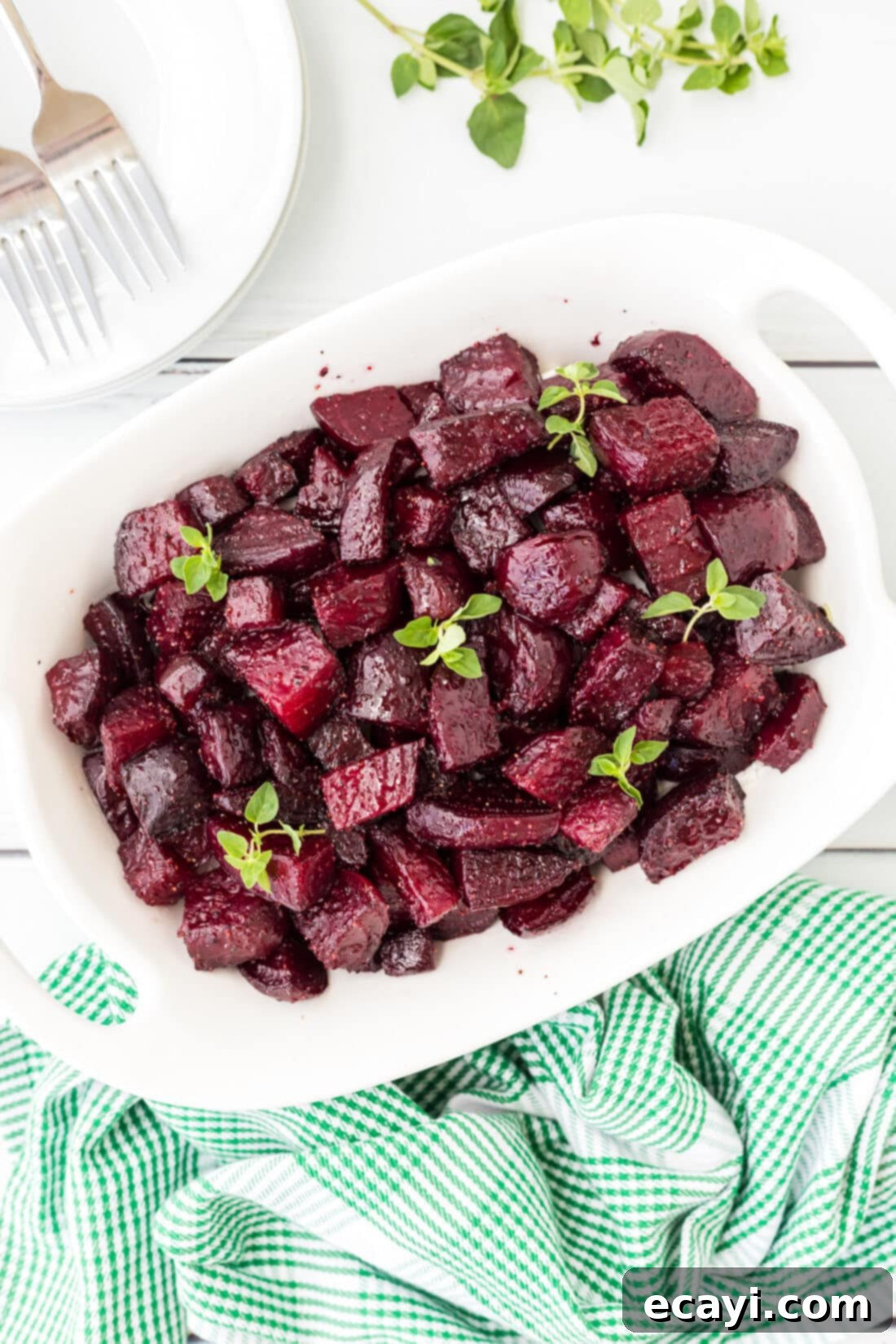
The Amazing Health Benefits of Beets
Beyond their delicious taste and vibrant color, beets are nutritional powerhouses. They are rich in essential vitamins and minerals, including folate, manganese, potassium, iron, and vitamin C. Beets are also an excellent source of fiber, which is vital for digestive health. Perhaps most notably, beets contain unique compounds called betalains, which are responsible for their deep red color and possess potent antioxidant and anti-inflammatory properties. Incorporating roasted beets into your diet can support heart health, boost athletic performance, and contribute to overall well-being. This simple roasting method preserves many of these beneficial nutrients, making it a healthy and delicious addition to your regular meal rotation.
Key Ingredients for Simple Roasted Beets
You’ll be surprised at how few ingredients are needed to create such a flavorful dish. For the precise measurements and detailed instructions, please refer to the printable recipe card available at the conclusion of this article. For now, let’s explore the simple components that make this dish shine:
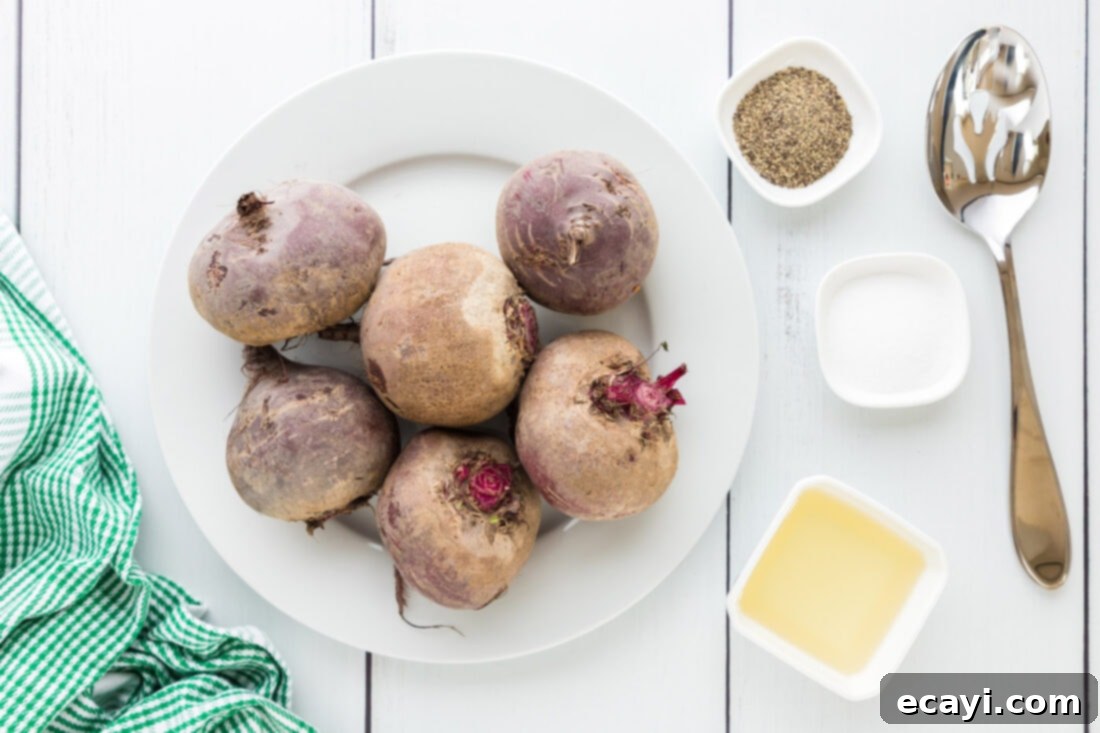
Ingredient Spotlight & Expert Tips
Understanding your ingredients is the first step to culinary success. Here’s a closer look at what you’ll need and how to make the most of each component:
BEETS – The star of our dish! When selecting fresh beets, always aim for those that are firm and heavy for their size, indicating freshness and good hydration. Avoid any with soft spots, wrinkles, or a dull appearance. Small to medium-sized beets are often preferred as they tend to be more tender and flavorful than very large ones. This recipe calls for approximately 2 pounds, which usually equates to about 6 medium beets. The initial boiling step, as highlighted, is crucial for effortless skin removal. Once boiled, the skins will practically slip off under gentle pressure. A vital tip for handling cooked beets: their vibrant pigment can easily stain hands, clothing, and countertops. It’s highly recommended to wear vinyl or latex gloves during peeling and chopping to protect your skin. If you do get stains, a little lemon juice or vinegar can help. While red beets are most common, feel free to experiment with golden beets for a milder, slightly sweeter flavor and no staining, or candy cane beets for a beautiful striped appearance.
OLIVE OIL – A good quality extra virgin olive oil is essential here. It coats the beets, facilitating even roasting and caramelization, while also adding a subtle fruity note that complements the earthy flavor of the beets. You can also try avocado oil or grapeseed oil as alternatives, though olive oil is preferred for its flavor profile.
SALT & PEPPER – Simple yet powerful. These basic seasonings enhance the natural flavors of the beets. We recommend using a good quality sea salt or kosher salt and freshly ground black pepper for the best results. Don’t be shy with the seasoning; beets can handle a fair amount. For an extra layer of flavor, consider adding a pinch of garlic powder, onion powder, or even a dash of smoked paprika before roasting.
Step-by-Step Guide: How to Make Tender Roasted Beets
These step-by-step photos and detailed instructions are provided to help you visualize each stage of making this delicious recipe. For a convenient printable version of this recipe, complete with precise measurements and comprehensive instructions, you can Jump to Recipe at the bottom of this post.
- Prepare for Boiling: Begin by bringing a large saucepan or a stockpot filled with water to a rolling boil over high heat. Ensuring a good boil is crucial for cooking the beets evenly.
- Boil the Beets: While the water heats, prepare your beets. Carefully trim off both the greens (leaving about an inch of stem) and the root ends, but do not peel them at this stage. Place the unpeeled beets into the boiling water. Partially cover the pot to maintain heat and boil for approximately 20 minutes, or until the beets are tender enough to be easily pierced with a fork. The cooking time may vary slightly depending on the size of your beets.
- Preheat Oven: As the beets are boiling, preheat your oven to 375°F (190°C). This ensures the oven is ready to go as soon as your beets are prepared for roasting.
- Drain, Peel, and Chop: Once tender, carefully drain the boiled beets. Allow them to cool slightly until they are comfortable to handle. Put on your protective gloves (this is where they are invaluable!). The skins should now easily slide off with gentle rubbing. If any spots are stubborn, use a small paring knife. After peeling, cut the beets into uniform bite-sized chunks, roughly 1-inch pieces. Consistency in size will ensure even roasting.


- Season the Beets: Transfer the chopped beets to a large mixing bowl. Drizzle them generously with olive oil, then sprinkle with salt and black pepper. Toss everything together thoroughly, ensuring each beet piece is evenly coated with the oil and seasonings. This even coating is key for optimal flavor and texture development during roasting.
- Roast to Perfection: Line a baking sheet with foil for easier cleanup. Spread the seasoned beet chunks out onto the prepared baking sheet in a single layer. Avoid overcrowding the pan, as this can steam the beets instead of roasting them, preventing proper caramelization. If necessary, use two baking sheets. Bake in the preheated oven for 20-25 minutes, or until the beets are tender and slightly caramelized around the edges, indicating they are perfectly roasted.

Frequently Asked Questions & Expert Tips for Roasted Beets
Once fully cooled, transfer your delicious roasted beets to an airtight container. They will keep beautifully in the refrigerator for up to 7 days. This makes them perfect for meal prep!
Freezing roasted beets is an excellent way to preserve them for longer. After roasting, allow the beets to cool completely. Then, place them in a large freezer-safe ziptop bag or an airtight container, ensuring you remove as much air as possible to prevent freezer burn. Properly stored, roasted beets can be kept in the freezer for up to 6 months. Thaw them in the refrigerator overnight before reheating gently in the oven or microwave.
Yes, you can roast beets without boiling them first. If you choose this method, you can either roast them whole (with skins on) or peeled and chopped. If roasting whole, wrap them in foil and bake until tender, then peel the skins afterwards (which can still be a bit tricky). If roasting peeled and chopped raw beets, they will take longer to cook and may not be as tender as the pre-boiled method, and peeling raw beets can be challenging. Our boiling-first method is designed for ease and superior tenderness!
Red beets are the most common and classic choice for roasting, offering a deep earthy flavor and beautiful color. Golden beets are slightly sweeter and less earthy, perfect if you prefer a milder taste or want to avoid staining. Chioggia beets (or candy cane beets) are visually stunning with their red and white rings, retaining some of their stripes when roasted, and have a milder flavor. Any of these varieties will work wonderfully with this recipe!
Before boiling, gently scrub the beets under cool running water using a vegetable brush to remove any dirt. Be careful not to scrub too vigorously, especially if the skins are damaged, as this can cause the color to bleed. Trim the greens and root ends, but avoid cutting too deeply into the beet itself to prevent color loss during boiling.
Additional Expert Tips for Perfect Roasted Beets:
- Even Sizing: When cutting the beets into chunks, try to make them as uniform in size as possible. This ensures they cook evenly and reach the desired tenderness at the same time.
- Don’t Overcrowd the Pan: For truly roasted (not steamed) beets with crispy edges, spread them in a single layer on the baking sheet. If you have too many beets, use two baking sheets or roast them in batches.
- Add Herbs and Spices: While salt, pepper, and olive oil are classic, don’t hesitate to experiment with other seasonings. Fresh or dried thyme, rosemary, garlic powder, onion powder, a pinch of cumin, or even a splash of balsamic vinegar before roasting can add fantastic depth.
- Acidity for Brightness: A squeeze of fresh lemon juice or a drizzle of balsamic glaze after roasting can brighten the flavors of the beets beautifully.
- Check for Doneness: Roasted beets should be fork-tender and slightly caramelized. If they still feel firm, give them a few more minutes in the oven.
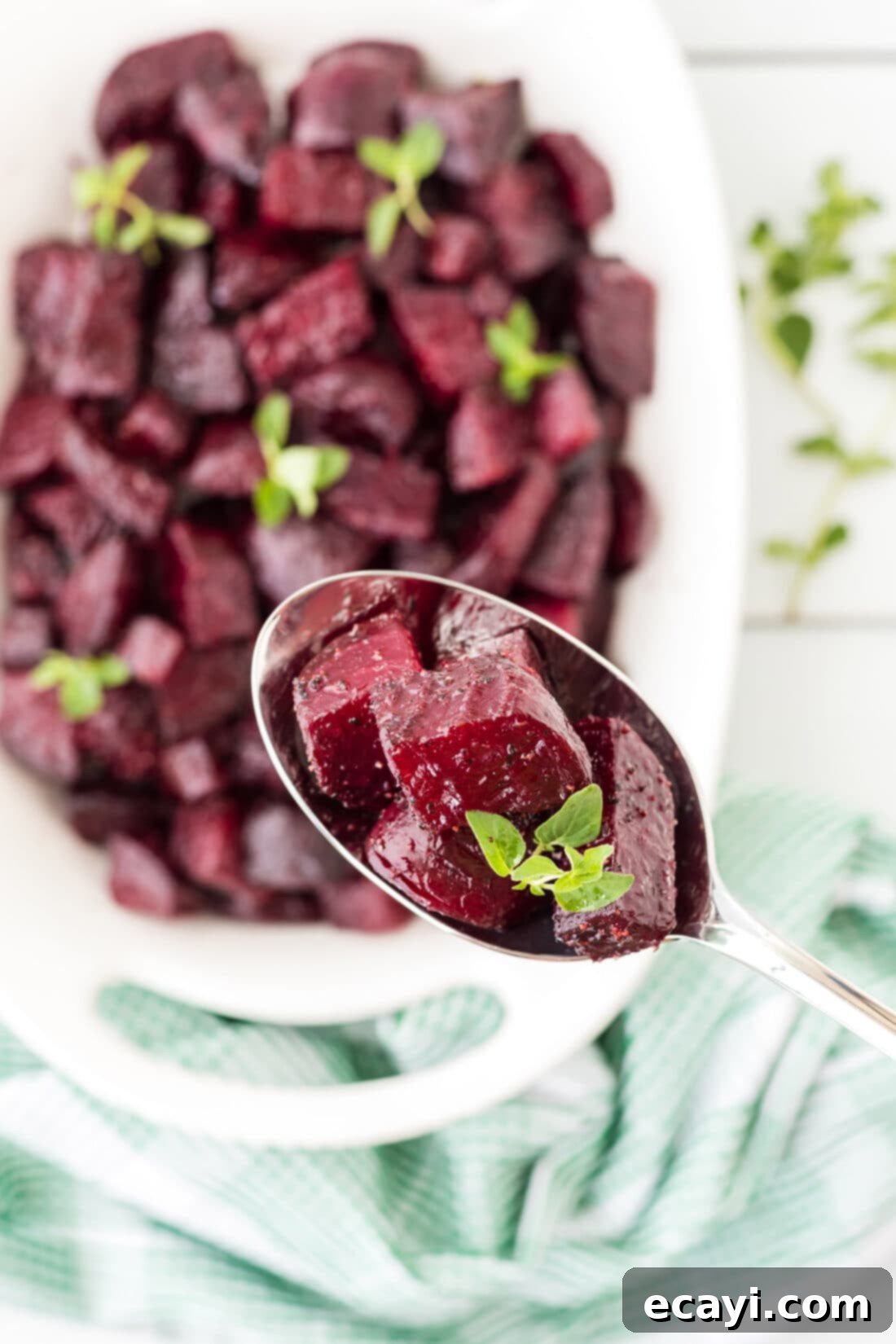
Creative Ways to Serve Your Roasted Beets
Once roasted, these tender and flavorful beets are incredibly versatile and can be enjoyed in countless ways. Their sweet and tangy profile makes them a fantastic addition to almost any meal. Serve them as a simple yet elegant side dish alongside roasted chicken, grilled fish, or steak. Toss them warm into fresh green salads with goat cheese, walnuts, and a light vinaigrette for a gourmet touch. They are also wonderful in grain bowls, pasta salads, or even blended into savory dips like hummus or a vibrant beet dip. For a unique twist, consider adding them to a strawberry beet smoothie for an unexpected nutritional boost, or incorporating them into a hearty winter salad with oranges and pistachios. Don’t be afraid to get creative – these roasted beets are sure to become a beloved staple in your kitchen!
Explore More Delicious Roasted Vegetable Recipes
Roasting vegetables is one of the simplest and most flavorful ways to enjoy their natural goodness. The caramelization achieved in the oven transforms even humble vegetables into crave-worthy dishes. If you loved these roasted beets, we encourage you to try these other fantastic roasted vegetable recipes:
- Perfectly Roasted Carrots
- Tender Roasted Asparagus
- Easy Pan Roasted Broccoli
- Flavorful Whole Roasted Cauliflower
- Crispy Roasted Potatoes with Rosemary and Garlic
I love to bake and cook and share my kitchen experience with all of you! Remembering to come back each day can be tough, that’s why I offer a convenient newsletter every time a new recipe posts. Simply subscribe and start receiving your free daily recipes!
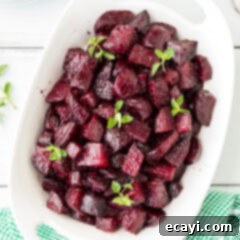
Roasted Beets
IMPORTANT – There are often Frequently Asked Questions within the blog post that you may find helpful. Simply scroll back up to read them!
Print It
Pin It
Rate It
Save ItSaved!
Ingredients
- 2 pounds fresh beets (about 6 medium beets)
- 2 Tablespoons olive oil
- 1 Tablespoon salt
- 1 Tablespoon black pepper
Things You’ll Need
-
Stockpot or large saucepan
-
Baking sheet
-
Cutting board
-
Chef’s knife
-
Vinyl gloves
Before You Begin
- Boiling the beets first is crucial for easy skin removal; once tender, the skins will effortlessly slide off.
- Store any leftover roasted beets in an airtight container in the refrigerator for up to 7 days.
- To freeze, ensure beets are fully cooled, then place them in a large ziptop bag, pressing out excess air. They can be stored in the freezer for up to 6 months.
Instructions
-
Bring a large saucepan or stock pot of water to a boil.
-
Cut off the beets’ greens and root ends, but do not peel. Place unpeeled beets in boiling water. Cover the pot partially and boil for 20 minutes, or until beets are tender and easily pierced with a fork.
-
Preheat oven to 375 F (190°C).
-
Drain beets. Using gloved hands, slide the skins off the beets. Cut into bite-sized chunks.
-
In a large bowl, toss beets with olive oil, salt, and pepper until evenly coated.
-
Spread beets out onto a foil-lined baking sheet in a single layer. Bake in preheated oven for 20-25 minutes, or until tender and lightly caramelized.
Nutrition
The recipes on this blog are tested with a conventional gas oven and gas stovetop. It’s important to note that some ovens, especially as they age, can cook and bake inconsistently. Using an inexpensive oven thermometer can assure you that your oven is truly heating to the proper temperature. If you use a toaster oven or countertop oven, please keep in mind that they may not distribute heat the same as a conventional full sized oven and you may need to adjust your cooking/baking times. In the case of recipes made with a pressure cooker, air fryer, slow cooker, or other appliance, a link to the appliances we use is listed within each respective recipe. For baking recipes where measurements are given by weight, please note that results may not be the same if cups are used instead, and we can’t guarantee success with that method.
